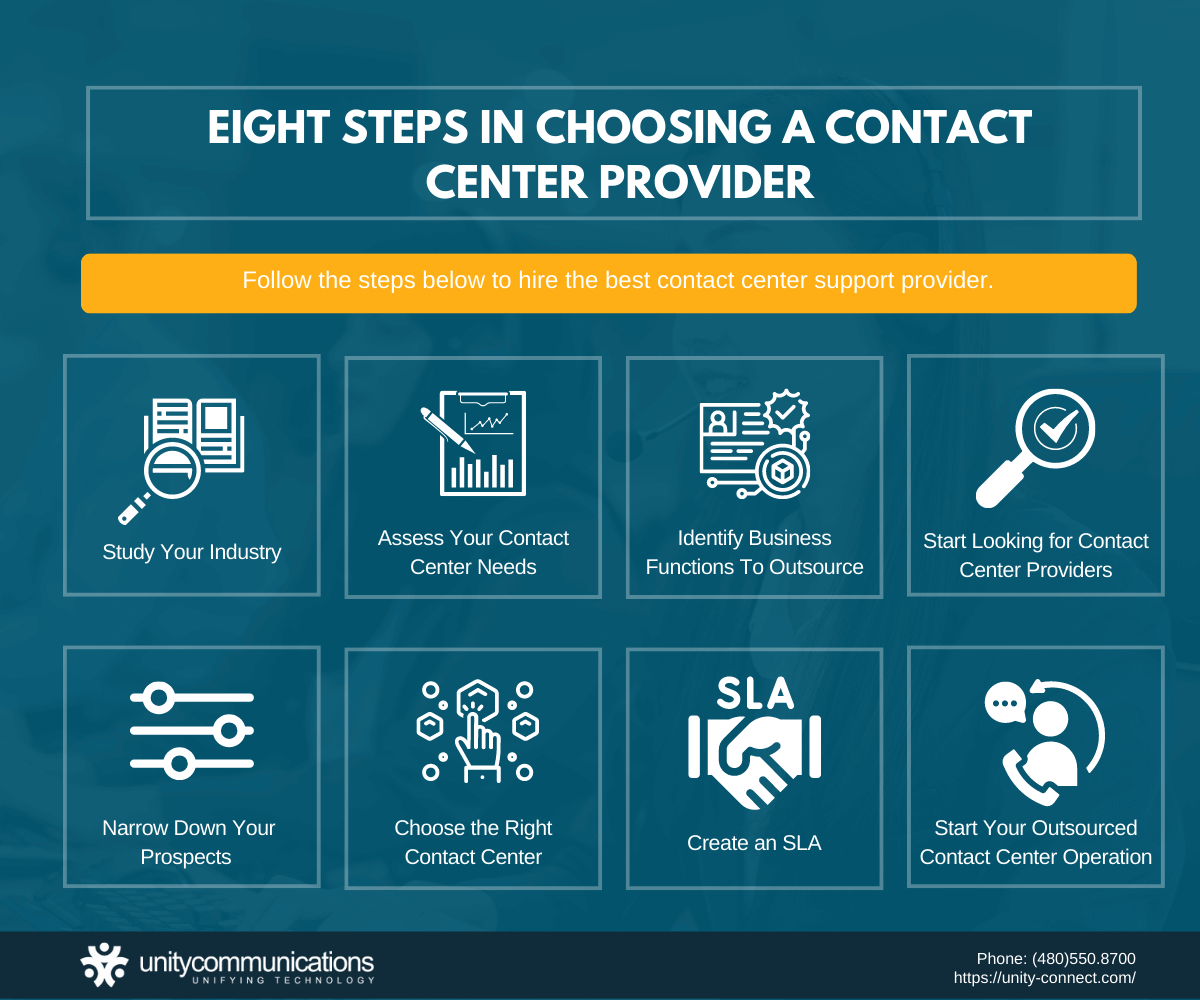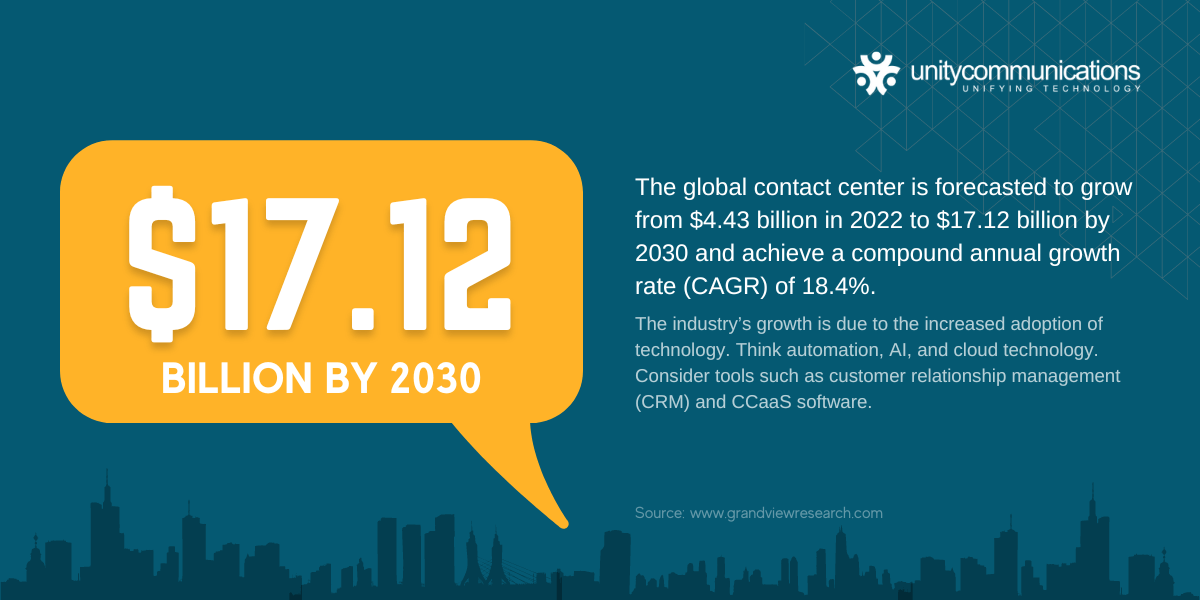Table of Contents
Robust customer interaction leads to business success. However, poor customer service leads to customer dissatisfaction and low profitability. Unfortunately, some companies lack staffing, technology, and resources for customer contact.
Thanks to advanced technology, call centers have evolved into contact centers. They now provide an enhanced customer experience.
Consider hiring a third-party service provider for your contact center. Pick a vendor with a skilled workforce, multiple channels, contact center as a service (CCaaS) software, and more.
This page will help you choose the best contact center support provider and help you learn some practical tips for your customer service operation.
Eight Proven Steps in Choosing the Right Contact Center Support Provider

Enhancing the customer experience is key to the success of your business. Choosing the right service provider is crucial to improving customer contact.
Follow the steps below to hire the best contact center support provider.
1. Study Your Industry
Start by assessing your industry. Keep tabs on market trends and understand customer needs. Use this information to find the right service provider for your business.
Understanding your industry’s dynamics is crucial when choosing the right contact center support provider. Stay informed about the latest trends and customer expectations.
The 2023 CCW Digital Contact Center Forecast highlights several key trends:
- a strong focus on digital transformation,
- heightened use of automation, the necessity of ensuring customer satisfaction,
- the growing importance of analyzing and acting upon customer insights, and
- bolstering customer loyalty.
Additionally, the future of contact centers is seen in embracing remote work, integrating AI in front- and back-office operations, and developing omnichannel solutions. Leveraging these insights will help you align with a service provider in tune with the industry’s future direction.
2. Assess Your Contact Center Needs
Evaluate your business’s own contact center needs after studying your industry. Consider two things.
- You probably have no contact center for your front-office functions, instead of building an in-house contact center, partner with a third-party service provider.
- You already have a contact center for your customer-facing functions. However, you must optimize your operation. A contact center support provider will help your business in concrete, bottom-line-oriented ways.
You must identify and meet your existing contact center needs as:
- Adequate staffing. Growing your business and expanding your market requires complete staffing. Whether for customer service or technical support, a third party will provide you with ample employees.
- Highly skilled employees. Having a complete workforce is not enough. You must have highly knowledgeable and skilled employees. Also, you need to train them before they hit production. Instead of hiring and training people, partner with a contact center support provider.
- Multiple channels. You probably have a call center for your front-office functions. But multichannel support has become the norm. About 60% of businesses now use more than two channels. Hence, consider having a third-party contact center to help with handling multiple channels.
- Technological resources. The use of technology is integral to a business. Think automation, artificial intelligence (AI), computer telephony integration (CTI), and CCaaS technology. Hiring a third-party service provider is best if you lack technological resources.
- Cost reduction. Outsourcing business processes is more economical than hiring new people and investing in resources. According to Deloitte, cost reduction is the top reason for outsourcing, which definitely applies to your contact center operation.
- Business scalability. A contact center support provider doesn’t only handle your customer-facing functions; they also help scale and grow your business.
3. Identify Business Functions To Outsource
Hubspot reports that customers have higher expectations than ever before. About 93% of service teams agree with this statement. Hiring a reliable contact center provider can help meet customer expectations.
Contact centers exist to communicate with your most important stakeholders—customers. But before taking the plunge and hiring a third-party provider, identify which business functions you want to outsource.
- Customer service involves assisting customers. The work scope varies, from answering questions and processing requests to handling complaints. Customers reach out to customer service representatives via different channels, including phone calls, email, and social media.
- Sales or telemarketing entails contacting customers to promote a brand. Telemarketers perform cold calling to offer products or services to potential customers. Sales representatives also conduct cold email outreach based on leads.
- Technical support is helping customers with technical needs. Technical support specialists troubleshoot computers, fix software and hardware, and address network issues.
4. Start Looking for Contact Center Providers
According to the Claes Fornell International (CFI) group, the United States has more than 40,000 contact centers. They employ 3.5 million agents, almost 5% of the U.S. working population.
What does this imply? Contact center support providers are readily available in the market.
So start searching for the best contact center service provider after deciding what business functions to outsource. You have three options.
- Search Online: The internet is a gold mine of resources. Simply do a Google search and get a list of contact center support providers. However, check each website along with its product or service page. From there, come up with a list of prospects.
- Get Recommendations: Get referrals from business partners, vendors, and other stakeholders. They’ll likely refer you to a few worthy prospects for a contact center.
- Expand Your Outsourcing: If you have already outsourced some functions, consider an expansion. Ask your current partner if they handle some front-office tasks. Instead of hiring a new provider, create a new contract with your existing partner.
5. Narrow Down Your Prospects Based on Five Factors
At this point, you already have a list of prospects for your contact center support. It’s time to narrow them down based on five factors.
- Business Reputation: Start by checking their credentials. Do they have the right licenses to operate? Have they received standard certification and business awards? Unity Communications, for instance, has recently earned its Great Place to Work (GPTW) certification. Consider a contact center that has received industry recognition.
- Services: Services offered vary from one contact center to another. Look for specialization and industry experience. See whether the services match your needs. Then narrow down your prospects based on their service relevance.
- Workforce: Employees are vital in a contact center because they interact directly with customers. However, agent effectiveness remains an issue. Hence, be thorough in how you choose your contact center support provider. Focus on six elements: agent demeanor, communication, knowledge, effectiveness, empowerment, and the IVR system.
- Technology: Companies cannot ignore technological advances to keep a competitive advantage. Hire a contact center support provider with the latest technology. The focus now is on digital transformation. Deloitte states that the top enablers are robotic process automation (72%), single-instance ERP (55%), and cloud tech (53%).
- Pricing Structure: Pricing is a determining factor in outsourcing. Remember that cost reduction is your end goal. Hire a contact center support provider that will meet your customers’ needs and cut your costs. Consider the pricing model that works for you, whether a fixed price (FP) or time and materials (T&M) model.
6. Choose the Right Contact Center Support Provider
Now, join the bandwagon by hiring a third-party service provider. Almost two-thirds of companies outsource some or all of their contact center services; about 70% plan to make outsourcing changes to their current arrangements.
Be sure to follow the steps mentioned above. To reiterate, consider these:
- Study your industry, identify your needs, and determine which functions to outsource.
- Create a list of prospects and narrow them down based on five factors.
Note: Your contracted service provider can make or break your contact center operation. Choose the one best suited for your business type and customer contact needs.
7. Create an SLA
Outsourcing doesn’t end with choosing a contact center support provider. You must create a service-level agreement (SLA). This contract defines the relationship between the company and its hired service provider.
An SLA covers all aspects of your business partnerships, lists the duties and responsibilities of both parties and sets key performance indicators (KPIs):
- Service efficiency measures how fast agents handle customer contact. It covers average handling time (AHT) and first contact resolution (FCR).
- Service quality measures the kind of service agents provide for customers. Quality analysts (QAs) monitor and audit contacts to ensure quality and compliance. The QA score is one of the most crucial metrics.
- Customer experience measures customers’ satisfaction or dissatisfaction with the services they have received. Customer satisfaction (CSAT) is the most important metric in a contact center.
8. Start Your Outsourced Contact Center Operation
Finally, your hired service provider helps kick off your contact center operation. Allow them to take control. However, make sure to provide the needed support at the outset. Remember that it’s a business partnership. Both parties should work hand in hand toward common business goals.
Five Practical Tips for Scaling Your Contact Center Operation

The global contact center might grow from $4.43 billion this year to $17.12 billion by 2030 and achieve a compound annual growth rate (CAGR) of 18.4%.
The industry’s growth is due to the increased adoption of technology. Think automation, AI, and cloud technology. Consider tools such as customer relationship management (CRM) and CCaaS software.
But what does this all mean? Companies must leverage the latest technologies to optimize their contact centers. However, there are several other ways to scale your operation. Consider the practical tips below.
1. Base Decision-making on Business Objectives
Every company has business goals. But they must set clear objectives for every endeavor. When hiring a contact center support provider, ask yourself what you seek to meet. Is it to:
- Boost your service efficiency;
- Improve your service quality;
- Achieve customer satisfaction;
- Generate more leads;
- Convert more sales; or
- Scale your operation and grow your business.
Note: Always make decisions based on your business objectives to ensure the success of your contact center operation.
2. Define KPIs in Your SLA
Earlier, we discussed the importance of including critical metrics in your SLA. KPIs serve as your reference for measuring performance and optimizing contact center operations. Below are the specific metrics to consider.
Service Efficiency:
- Average Handling Time: It is the average contact time spent with customers. It factors in the hold time and after-call work (ACW) in the calculation.
- Contact Abandonment Rate: It measures the number of times customers disconnect before interacting with agents.
- Occupancy Rate: This metric refers to how long agents perform work-related activities in a regular shift.
Service Quality:
- Quality Assurance Score: The QA score measures how agents adhere to quality contact workflows.
- Compliance Score: The compliance score measures agents’ adherence to business policies.
Customer Satisfaction:
- Customer Satisfaction Score: The CSAT score is the most important key metric. It measures whether customers are satisfied with the services received.
- First Contact Resolution: FCR measures how agents resolve issues during the first contact.
- Net Promoter Score: NPS measures customer experience and loyalty based on customers’ promotions.
3. Invest in Human and Material resources
The five factors mentioned earlier in choosing a contact center support operation include the workforce and technology.
But after hiring a service provider, offer to invest in human and material resources. They will help optimize your contact center operation. Take note of the following.
Workforce:
- BPO agents: The business process outsourcing agents are the frontline employees working directly with customers. Make sure to get the best talent. Also, train them to be adept at what they do, whether it is customer service, sales, or tech support.
- Quality Analysts (QAs): The QA team plays a crucial role in a contact center. They track agent performance, ensure quality service, and improve business operations.
- Compliance Specialists: The compliance team works hand in hand with the QA team. However, these specialists focus on adherence to business protocols to help prevent penalties, legal ramifications, and a shutdown.
- Management Team: This team serves as a bridge between the client and the workforce. They meet the client’s needs and provide employees with the utmost support.
Technology:
- CTI Technology: This technology enables phones to work with computers. It has advanced features such as automated dialing, routing, recording, monitoring, analytics, etc.
- CCaaS Software: This software is a cloud-based, provider-hosted technology for customer contact. It’s an effective solution for optimizing a contact center and enhancing customer experience.
- UCCaaS Software: It stands for unified communications as a service. This technology is also cloud-based software. It provides employees with a unified platform for communication and collaboration.
- CRM Software: CRM stands for customer relationship management. This tool lets you record and manage customer interactions via a centralized platform.
- Workforce Management Software: This software is for workforce analysts. This also helps them forecast, schedule, and manage employees.
- Email Management System: This system is for email communication for a contact center. It allows employees to receive emails and respond to customers.
- Web Chat Platform: This platform enables live customer interaction via a web interface and lets employees chat with customers in real time.
- Social Media Channels: Businesses now use Facebook, Messenger, and Instagram for customer service.
- Self-service Portals: Companies provide customers with self-service options. Interactive voice response (IVR) and online resource pages are a few examples.
4. Ensure Regular Communication and Collaboration
Constant communication and collaboration are crucial to operational success. Once you’ve hired a third-party provider, you must continue to build the relationship.
Don’t leave the operation entirely to your service provider. While allowing your partner to take control, you must stay on top of all activities. In the end, outsourcing means pursuing business partnerships.
5. Monitor Your Operation and Track Your Progress
You should monitor your contact center operation regularly. To track your progress, check your SLA.
- First, get monthly reports to see if your provider is hitting the metrics.
- Second, review your business objectives and see whether they meet them.
If not, make some necessary changes to optimize your operation.
The Bottom Line
Enhancing your customer experience remains a pivotal factor in streamlining your contact center operations. Achieving this hinges on assembling a proficient team, adopting cutting-edge technology, and ensuring the availability of essential resources.
Unity Communications is your reliable partner for elevating your contact center capabilities. We specialize in delivering top-notch support and solutions tailored to your business needs.
Take the first step towards optimizing your contact center today. Contact Unity Communications to explore how our expertise can drive your success. Don’t overlook our practical tips for scaling your operation, as they hold the key to unlocking the full potential of your customer service.
With these strategies, your contact center operation is poised for growth and excellence. This transformation will translate into heightened customer satisfaction and a substantial increase in profitability. Reach out to Unity Communications now to embark on this journey to success.




